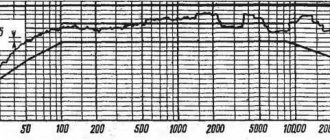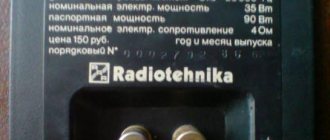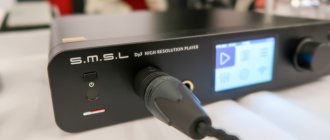| VEF Radiotehnika RRR | |
| Type | Joint-Stock Company |
| Base | 1927 |
| Former names | Foto–radio centrāle A. Leibovic, Radiopionieris, Riga Radio Plant named after A. S. Popov, Radio Engineering Production Association |
| Founders | Abram Leibowitz |
| Location | Latvia Latvia: Riga |
| Key figures | Eduard Maleev, Yuri Maleev, Inga Spruga, Janis Salenieks |
| Industry | radio engineering, acoustic systems |
| Turnover | €1.878 million (2011)[1] |
| Net profit | 7 thousand euros (2011)[1] |
| Website | [www.rrr.lv (Russian) (Latvian) (English)] |
K:Companies founded in 1927
VEF Radiotehnika RRR
(Akciju sabiedrība “VEF Radiotehnika RRR”) (stands for Rīgas Radio Rūpnīca - Riga Radio Plant) is a Latvian manufacturer of radio equipment and speaker systems. Founded in 1927. Located in Riga, Latvia.
Story
The joint stock company "VEF Radiotehnika RRR" was founded in 1927 by Abram Leibovitz as the joint stock company "Foto - radio centrāle A. Leibovic". The government of the young state tried in every possible way to help local equipment manufacturers in order to organize their production in the country. Due to the laws introduced by the Latvian government, it was unprofitable to simply import radio equipment, so A. Leibowitz began buying finished products from companies such as Lumophon, Kramolin, Loewe-Optha abroad, disassembling them on site and importing them into Latvia under the guise of radio components. And the finished products were sold under their own brand name ALRadio. In 1940, with the advent of Soviet power, the enterprise was nationalized and merged with the Kolifox company, also involved in radio engineering, and received the name Radiopionieris. During the Second World War, already under German occupation, the company was merged with the company A. Apsītīs and F. Žukovskis and received its current name - Radiotehnika. In the post-war period, the Riga Radio Plant named after. A. S. Popova (later the Radiotekhnika production association) became the largest manufacturer of audio equipment in the Soviet Union. Its products were marked with the RRR logo. In 1991, after Latvia left the USSR, VEF Radiotehnika RRR JSC became one of the largest manufacturers of household and professional Hi-Fi acoustics in Eastern Europe.
Second dad
In the thirties, Leibowitz hired a brilliant technician who, at the age of 22, won a Ministry of Internal Affairs competition and assembled two hundred regenerative three-tube battery radios for border guards.
Alexander Apsitis, who is often mistakenly considered the founder of the Riga plant, worked for Leibovitz for only a short time, since they did not agree on some work issues. Subsequently (in 1934), Apsitis decides to register his production: which produces Tonmeistars receivers and also produces radio accessories. At the same time, Leibowitz has a new problem: Adolf Hitler comes to power in Germany, which aggravates the “Jewish question.” At the beginning of his reign, the country's enterprises were advised not to work with representatives of this nationality, so Leibovitz lost his main supplier of radio components, and he had to start developing his own models.
The strategies of Leibovitz's and Apsitis's enterprises were completely different: the first was a “merchant to the core”, he attracted customers due to the appearance of his goods and powerful advertising. The absolutely commercial component of Leibowitz's business made itself felt: if there was an opportunity to make a profit due to loss of quality, he did not miss it. This is still affecting us - now original radio receivers of his production are extremely difficult to find in working condition.
Apsitis, being an excellent radio engineer, was chasing quality. His different models sometimes differed little from each other in appearance, but were assembled perfectly. Ultimately, it was Apsitis who made the maximum contribution to the development of the enterprise, which would later become known as “Radiotehnika”.
An excerpt characterizing Radiotehnika RRR
“Nothing, Mama, really nothing, just like this: Petya scared me,” she said, trying to smile, but the tears kept flowing and sobs were choking her throat. Dressed up servants, bears, Turks, innkeepers, ladies, scary and funny, bringing with them coldness and fun, at first timidly huddled in the hallway; then, hiding one behind the other, they were forced into the hall; and at first shyly, and then more and more cheerfully and amicably, songs, dances, choral and Christmas games began. The Countess, recognizing the faces and laughing at those dressed up, went into the living room. Count Ilya Andreich sat in the hall with a radiant smile, approving of the players. The youth disappeared somewhere. Half an hour later, an old lady in hoops appeared in the hall between the other mummers - it was Nikolai. Petya was Turkish. Payas was Dimmler, hussar was Natasha and Circassian was Sonya, with a painted cork mustache and eyebrows. After condescending surprise, lack of recognition and praise from those not dressed up, the young people found that the costumes were so good that they had to show them to someone else. Nikolai, who wanted to take everyone along an excellent road in his troika, proposed, taking ten dressed up servants with him, to go to his uncle. - No, why are you upsetting him, the old man! - said the countess, - and he has nowhere to turn. Let's go to the Melyukovs. Melyukova was a widow with children of various ages, also with governesses and tutors, who lived four miles from Rostov. “That’s clever, ma chère,” the old count picked up, getting excited. - Let me get dressed now and go with you. I'll stir up Pashetta. But the countess did not agree to let the count go: his leg hurt all these days. They decided that Ilya Andreevich could not go, but that if Luisa Ivanovna (m me Schoss) went, then the young ladies could go to Melyukova. Sonya, always timid and shy, began to beg Luisa Ivanovna more urgently than anyone not to refuse them. Sonya's outfit was the best. Her mustache and eyebrows suited her unusually. Everyone told her that she was very good, and she was in an unusually energetic mood. Some inner voice told her that now or never her fate would be decided, and she, in her man’s dress, seemed like a completely different person. Luiza Ivanovna agreed, and half an hour later four troikas with bells and bells, squealing and whistling through the frosty snow, drove up to the porch. Natasha was the first to give the tone of Christmas joy, and this joy, reflected from one to another, intensified more and more and reached its highest degree at the time when everyone went out into the cold, and, talking, calling to each other, laughing and shouting, sat in the sleigh. Two of the troikas were accelerating, the third was the old count’s troika with an Oryol trotter at the root; the fourth is Nikolai's own with his short, black, shaggy root. Nikolai, in his old woman's outfit, on which he put on a hussar's belted cloak, stood in the middle of his sleigh, picking up the reins. It was so light that he saw the plaques and eyes of the horses glinting in the monthly light, looking back in fear at the riders rustling under the dark awning of the entrance. Natasha, Sonya, m me Schoss and two girls got into Nikolai’s sleigh. Dimmler and his wife and Petya sat in the old count’s sleigh; Dressed up servants sat in the rest.
A decade of success and decline
The eighties became “golden” for “Radiotekhnika” - the rate of production of radio equipment is growing, the plant produces approximately 35% of all Soviet audio equipment.
Cassette recorders ML-6201 appear with a tuner, two speaker systems, a tape recorder and ULF. At this time, the Radiotekhnika association also included the Orbita Design Bureau and the Emira Microelectronics Plant. The “Duets PM-8401” cassette player appears, to which you can connect two pairs of headphones at once.
The company produces a million radios, amplifiers and tape recorders and more than a million speaker systems per year. This dizzying success continued until the collapse of the USSR.
Political events in the world, the gaining of independence of Latvia and economic reforms were accompanied by a massive entry into the market of Chinese cheap consumer goods on the one hand and products of well-known, primarily Japanese, brands, on the other. Radiotekhnika was disbanded into several autonomous enterprises, which is why the giant of the radio industry fell into even greater decline. Unable to withstand competition with imported models, the plant discontinues some of its products.
At the same time, prices for parts produced in the countries of the former Soviet Union are rising, prices for the plant’s products have to be raised, but they are no longer sold out, since they are obsolete compared to new products from abroad. The plant cannot afford to develop new models, since its design bureau does not receive sufficient funding.
A typical situation began for many factories in the 90s: wage debts were growing, but there was practically no profit. Most of the enterprises that arose after the dissolution of Radiotekhnika almost immediately “died,” including the Orbita Design Bureau.
Despite futile attempts to adapt to the new market, in 1993, the Riga Radio Plant, which survived the collapse of Radiotekhnika, was divided into two parts by the State Property Fund. One was subsequently declared bankrupt. The second part turned into “Radiotehnika RRR”, which was bought at auction in 1998 by businessmen Eduard and Yuri Maleev.
Why do most people consider Radiotehnika S-90 speakers to be firewood?! Is it worth buying them in 2022?
I will express my opinion, which is based on fairly rich experience in operating domestic speaker systems, the so-called S-90 series.
At one time, almost all speaker systems were included in a home audio system in various combinations of a stereo path.
I can say unequivocally that the best speaker systems from the line of the Riga Popov RRR plant were the very first model developed in the late 70s, namely the Olympic 35AC-1. My acquaintance with these speakers began in my home system in conjunction with the Melody -105M Stereo music system. To replace the standard “pipes” 6 AC-2. 35AS-1 were purchased through a lot of connections at the Orbita AS store.
After purchasing new speakers, the sound of the system has changed dramatically! Vinyl and VHF stations sounded much more alive, more natural, the scale of the sound was added, as they say now, the stage became much wider. Of course, the bass became truly deep, as if velvety. the standard cassette deck of the kit (Hungarian production) showed its shortcomings in sound to an even greater extent. At that time, I had quite a lot of friends whose home systems had imported equipment. Naturally, we often did experiments to compare sound. For example, one friend at home had an incredibly cool Pioneer block system with large three-way speakers... But even with a closer comparison, our 35AC-1 played much more interesting than the Pioneer speakers. in Pioneer the speakers were made of thin-walled chipboard, speakers (woofers) with a tiny magnet and a tiny stamped basket...))) Yes, the system looked beautiful, but the sound was clearly inferior to our 35 speakers. What first struck the ears was not the deep bass and the very noticeable “boxy, cardboard-like sound” in the low frequencies and not the high overload capacity. The acoustics in the sound clearly emphasized loud vocals and raised highs, while the speakers had a very compressed and “poor” bass. And the size of the woofer in the Pioneer speaker was neither more nor less -30cm!)))
Then, a friend once threw a loud party at home and the result was sad - in one speaker, first the woofer’s voice coil burned out, and then the output transistors in one channel of the amplifier burned out. I had to select domestic analogues of transistors and repair the woofer. This is, so, a small lyrical digression on the topic of the myth about “unbreakable Japanese equipment”)))
I don’t even know if this Pioneer is alive now, but my 35ACs still serve well and delight me with their “vintage sound” at the dacha…. True, with a little modification, the midrange speaker was replaced with a 4GD-8e, a PAS was made for the midrange, the filters were redesigned, the wiring was replaced, and the midrange and high-frequency level switches were removed. The body is reinforced with spacers and good connectors are installed. And most importantly, I had the opportunity to select a pair of bass drivers with very similar parameters... By the way, the bass drivers in the 35 AC-1 were made on cobalt, in contrast to further upgrades of the bass drivers of the S-90 AC series.
By the way, the body of our speakers was made not from pressed wood “sawdust”, as in the Pioneer, but from high-quality birch plywood covered with natural wood veneer...
Then, I went through almost all the upgrades of the S-90 and after my 35 speakers, the most interesting in terms of sound were the 35AC-008 “Corvette”, although due to the closed cabinet and the small volume of the cabinet, the bass of the Corvettes was greatly compressed in terms of dynamics and depth….
Then, though not for long (about a year), the system had Electronics 100-AS-060, acoustics, undoubtedly very worthy and the best sounding that had ever been developed in the USSR, but this is another topic for conversation... So what if If anyone is thinking of buying decent sound inexpensively, I recommend buying 35AC-1(201) or Corvette 35AC-008(208). with minor modifications, these speakers can easily compete with modern bassless Chinese speakers at a cost of up to 1000 bucks. The only remark is that for proper sound you need a decent-sized listening room... And a decent amplifier... For the first time, it’s quite a worthy option!))) Everything said above is my personal opinion on the issue of domestic acoustics.
But something still lives
In 2011, World Audio Distribution, part of the group, launched its own full-cycle acoustics production in Riga - from the manufacture of cabinets to finished products under the Arslab brand.
Previously, Arslab speakers were manufactured in China. The choice for Riga fell, among other things, because of the specialists living there who previously worked for. Now the head of production is Viktor Lagarpov, who used to be the chief engineer at Radiotekhnika. Thanks to the experience gained at the legendary plant, Victor knows everything about acoustics. Over the six years of operation of the enterprise, the plant’s capabilities have expanded significantly - additional German machines were purchased and new personnel were hired. In 2022, the number of workers employed directly in production reached fifteen people. In addition to assembling acoustics and producing the necessary electronic components, the factory also produces housings for speakers (unlike many audio system manufacturers who buy ready-made ones from third-party companies). The company also produces a large number of cases for other manufacturers from Germany, France, Italy and other countries.
In 2014, World Audio Distribution acquired a majority stake in Penaudio, whose products are now also manufactured at the plant. As Penaudio founder Sami Penttilä himself, who continues to lead the company, states, the quality of finished products has increased. And production capabilities are now sufficient to satisfy the demand for these acoustics all over the world.
In addition to “traditional” home audio systems (under the Arslab, Old School and Penaudio brands), the plant began producing equipment for ICE home cinemas in 2016. This is another own brand of Audiomania. This acoustics was also developed by F-Lab under the leadership of the famous engineer Yuri Fomin.
ICE, Old School and Penaudio acoustics, assembled at the plant in Riga, are sold not only in Latvia and Russia, they are in great demand all over the world, including China, Taiwan, Japan, the USA, Mexico and European countries.
According to our forecasts, the number of products produced in 2022 under Audiomania’s own brands will approach one thousand, which means an almost twofold increase compared to 2016. You can read more about what production looked like a few months ago in our reports: and.











